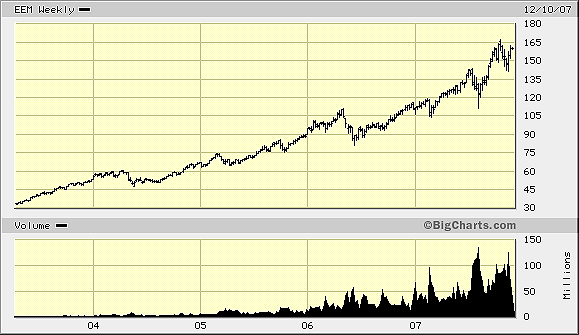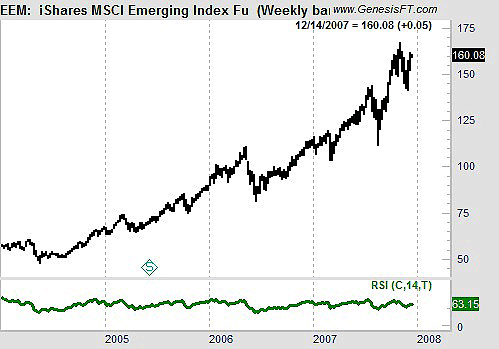
HOT TOPICS LIST
- MACD
- Fibonacci
- RSI
- Gann
- ADXR
- Stochastics
- Volume
- Triangles
- Futures
- Cycles
- Volatility
- ZIGZAG
- MESA
- Retracement
- Aroon
INDICATORS LIST
LIST OF TOPICS
PRINT THIS ARTICLE
by Mike Carr, CMT
With technical signs of a top developing, EEM should be added to a list of potential short candidates.
Position: Sell
Mike Carr, CMT
Mike Carr, CMT, is a member of the Market Technicians Association, and editor of the MTA's newsletter, Technically Speaking. He is also the author of "Smarter Investing in Any Economy: The Definitive Guide to Relative Strength Investing," and "Conquering the Divide: How to Use Economic Indicators to Catch Stock Market Trends."
PRINT THIS ARTICLE
Fundamental Risk In Emerging Markets
12/12/07 09:42:10 AMby Mike Carr, CMT
With technical signs of a top developing, EEM should be added to a list of potential short candidates.
Position: Sell
| iShares MSCI Emerging Markets Index Fund (EEM) is an exchange traded fund (ETF) that tracks the performance of stock markets in global emerging markets. Its largest holdings are in South Korea, China, and Brazil. Other countries represented in the portfolio include Russia, Mexico, and India. Buying EEM represents a bet that emerging markets will outperform more developed markets like the US or European economies. We would expect these markets to grow faster than the larger markets we usually trade, so EEM has been a good long-term investment (Figure 1). |

|
| FIGURE 1: EEM, WEEKLY. EEM is showing a gain of approximately 450% in less than five years. |
| Graphic provided by: BigCharts.com. |
| |
| More recent chart action may indicate a topping pattern is being formed. A break of support at 140 would coincide with a break of long-term trendline support and indicate a change in trend for this stock. The weekly chart also shows a bearish relative strength index (RSI) divergence on the most recent price high (Figure 2). |

|
| FIGURE 2: EEM, DAILY. Here, EEM shows a small bearish divergence forming. |
| Graphic provided by: Trade navigator (www.GenesisFT.com). |
| |
| More troubling is a fundamental factor. Jay McCormick of Helm Investment Management noticed that the historical relationship between the P/E ratios of EEM and ETFs for more developed markets, like SPY or EAF, changed recently. EEM for perhaps the first time has a higher P/E ratio than SPY and EAF. |
| According to the iShares website, EEM had a P/E ratio of 23.30, higher than the P/E ratio of the Standard & Poor's 500, which is 21.58. These numbers were as of the end of October and change daily, but EEM has retained a higher ratio since then. Higher P/E ratios indicate that there is more risk in the stock. At current levels, investors may be implying that they think the US market is less risky than the emerging markets of the world. |
| This change in fundamentals is likely to be temporary. When the bubble in emerging markets pops, EEM should fall harder than stocks in developed markets. This makes EEM a great short candidate, near 140 for conservative investors or at current levels for more aggressive traders. |
Mike Carr, CMT, is a member of the Market Technicians Association, and editor of the MTA's newsletter, Technically Speaking. He is also the author of "Smarter Investing in Any Economy: The Definitive Guide to Relative Strength Investing," and "Conquering the Divide: How to Use Economic Indicators to Catch Stock Market Trends."
| Website: | www.moneynews.com/blogs/MichaelCarr/id-73 |
| E-mail address: | marketstrategist@gmail.com |
Click here for more information about our publications!
Comments

|

Request Information From Our Sponsors
- StockCharts.com, Inc.
- Candle Patterns
- Candlestick Charting Explained
- Intermarket Technical Analysis
- John Murphy on Chart Analysis
- John Murphy's Chart Pattern Recognition
- John Murphy's Market Message
- MurphyExplainsMarketAnalysis-Intermarket Analysis
- MurphyExplainsMarketAnalysis-Visual Analysis
- StockCharts.com
- Technical Analysis of the Financial Markets
- The Visual Investor
- VectorVest, Inc.
- Executive Premier Workshop
- One-Day Options Course
- OptionsPro
- Retirement Income Workshop
- Sure-Fire Trading Systems (VectorVest, Inc.)
- Trading as a Business Workshop
- VectorVest 7 EOD
- VectorVest 7 RealTime/IntraDay
- VectorVest AutoTester
- VectorVest Educational Services
- VectorVest OnLine
- VectorVest Options Analyzer
- VectorVest ProGraphics v6.0
- VectorVest ProTrader 7
- VectorVest RealTime Derby Tool
- VectorVest Simulator
- VectorVest Variator
- VectorVest Watchdog
